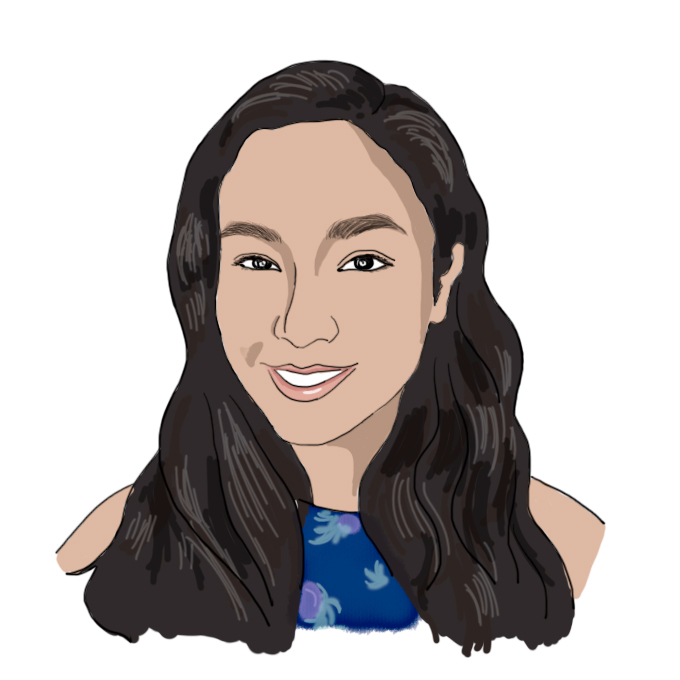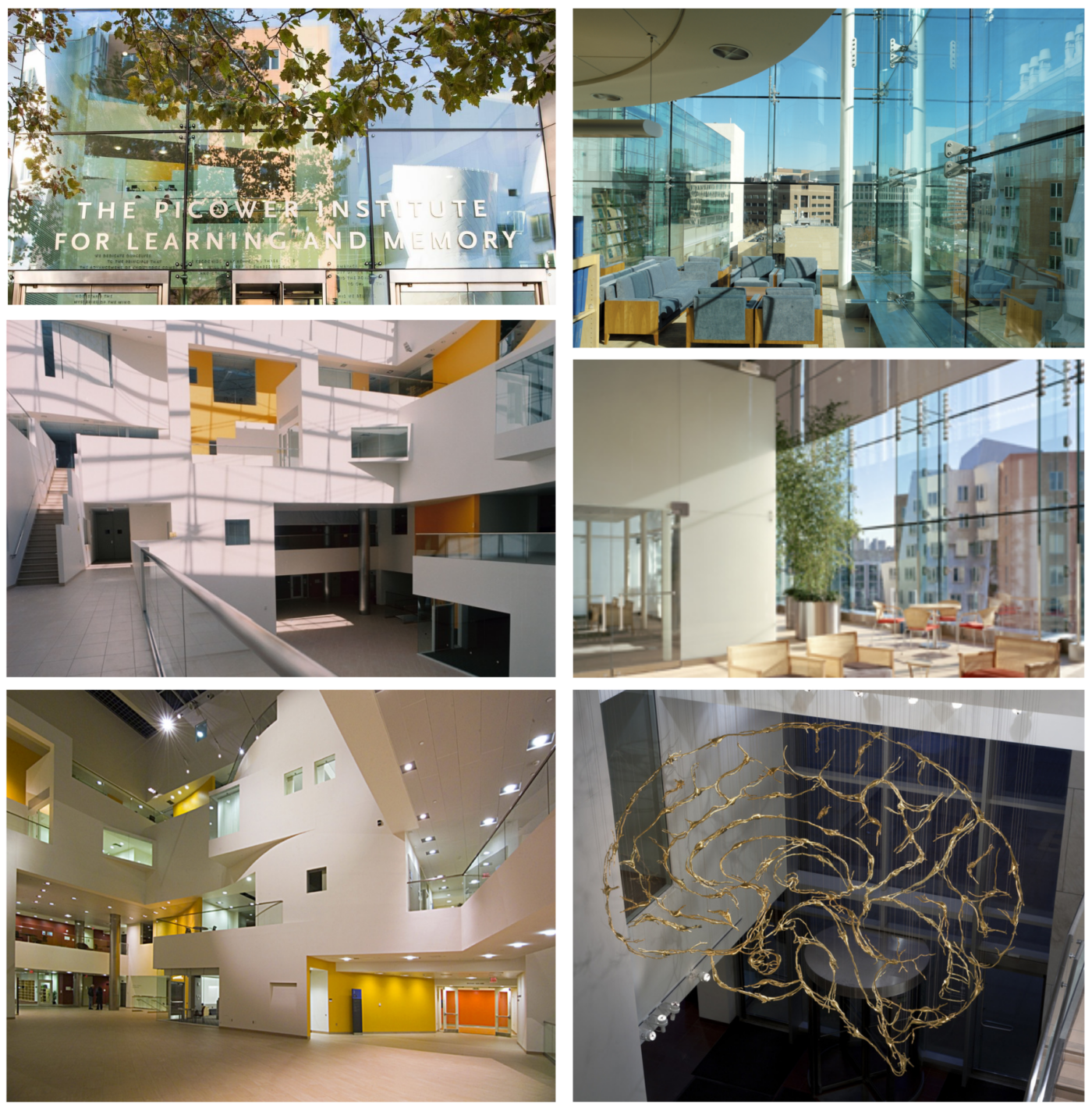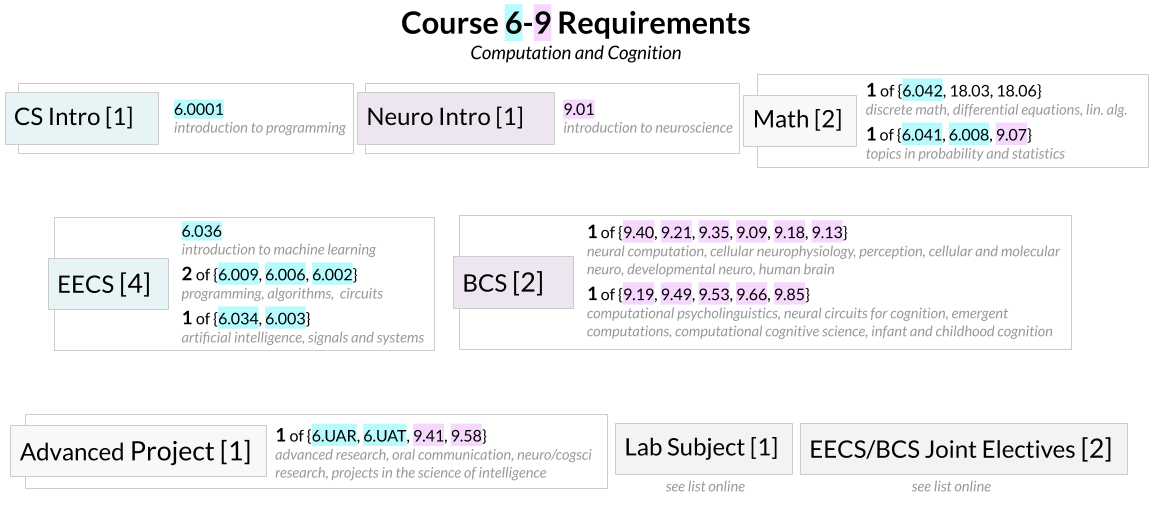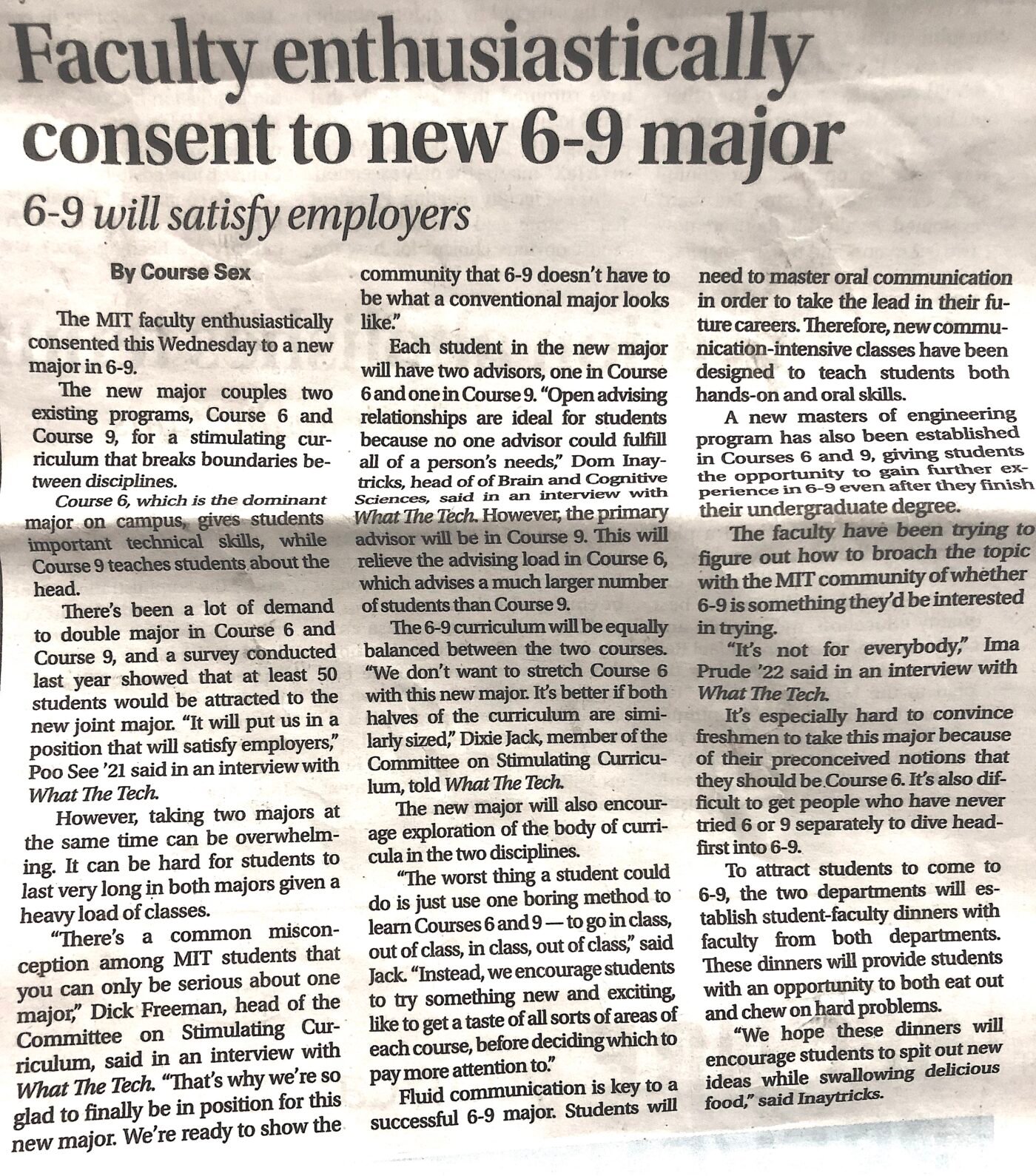
My Major, Course 6-9 by Kathleen E. '23
computation and cognition
I get a lot of questions about it’s like to major in “Computation and Cognition,” known around MIT as Course 6-9. In this post, I’ll describe my experiences with Course 6-9 and give an overview of what the major is like overall.
Table of Contents
- How I Chose Course 6-9
- What is Course 6-9?
- Internships as a 6-9 (Anything you want!)
- Perks and Drawbacks
- My Advice for Future Course 6-9s
- Memes
Individually, “Course 6” refers to students who study Electrical Engineering and/or Computer Science (EECS) and “Course 9” refers to students studying Brain and Cognitive Sciences (BCS). Course 6-9 (Computation and Cognition) is a joint major between the two departments! It was announced in the spring of 2019 and remains MIT’s newest01 and nicest, in my opinion major.
How I Chose Course 6-9
Before MIT: Discovering computational neuroscience
I went to a three-week neuroscience-focused summer camp when I was 15. It was there that I learned what an action potential was. I also dissected a sheep brain. After camp, I forgot about neuroscience for a while, until the summer after my junior year of high school. That summer, I found myself at a local university, working in a neuroscience lab through a high school research program. This time, there were no sheep brains to dissect. My entire project was done on my laptop.
I was working in a subfield of neuroscience research called computational neuroscience. Wikipedia provides a pretty good definition of what this is:
Computational neuroscience (also known as theoretical neuroscience or mathematical neuroscience) is a branch of neuroscience which employs mathematical models, theoretical analysis and abstractions of the brain to understand the principles that govern the development, structure, physiology and cognitive abilities of the nervous system.
Over my summer in the lab, I learned two things: how to code and how to investigate questions about the brain using quantitative approaches. I found myself very interested in both neuroscience and computer science – I was fascinated by the brain, especially perception, and enthralled by the vast opportunities that computer science could unlock for me. I decided that, moving forward into college, I didn’t want to choose one discipline over the other. My parents and teachers were confused by this, but I knew from my summer research that I could rock the intersection.02 These days, there are really careers for computational-anything!
As my summer in the lab ended, the college application season started. As I began writing my applications, I researched many different universities to see what kinds of programs and opportunities they had in neuroscience and computer science. I also looked at each university’s general approach to accommodating students who were undecided or diverse in their interests. Some universities admitted into individual schools within the university and then restricted what majors/minors students could declare, while other universities (like MIT) allowed admitted students to switch into any major or double major across any fields.
I was disappointed to see that many universities were very interdisciplinary at the faculty level (most of them had many computational neuroscience research faculty), but rather monodisciplinary at the undergraduate level. Extremely few of them had opportunities in their undergraduate program to focus on computational neuroscience. Very few even had electives which touched on computational neuroscience.
Like most of its peers, MIT didn’t have a computational neuroscience degree program for undergraduates. However, its regular neuroscience program (Course 9, Brain and Cognitive Sciences) stood out to me anyway because it included computational and quantitative requirements (specifically, 6.00, 9.07, and 9.40). Moreover, outside of the requirements, MIT had a lot of electives in both Course 9 and Course 6 which included or even focused on computational neuroscience. In contrast, most other schools’ neuroscience programs felt too traditional or pre-medical, only requiring classes in non-computational biology, neurobiology, and psychology.
When it came time to choose a school, I felt like it was easy for me to pick MIT over the other schools I was considering. MIT had an unparalleled number of opportunities for scientists and engineers and the neuroscience department had fantastic computational neuroscience opportunities (both in the classroom and in the lab).
At MIT: Course 6-9 is born!
When I arrived to MIT, I thought I would pursue a double major in Course 6 and Course 9. I felt a bit uneasy about attempting a double major, however. Doing a double major means you have to satisfy many more requirements than if you do a single major. This is often justified – if you want to have mastery over two areas, you’ll need to complete requirements for both – but makes less sense in the context of wanting to study the intersection of two areas, for which getting the traditional education in two separate fields may not actually spur as much success as focusing on the intersection itself.
Doing a double major felt like a bad idea because it meant I would have less time to invest in pursuing a minor in one of my secondary interests (like math, physics, or public policy), taking electives, or being more involved on-campus outside of classes.
Luckily, within a few weeks after arriving to MIT, I started hearing rumors that a new joint major between Course 6 and Course 9 was in the works. I was fine with the rumors being just that – rumors – until the spring when the due date to declare my major crept closer.03 You can change your major at any time after this date. It's just a way to get students matched with an advisor and start creating a plan to complete their degree requirements. I wanted to know if the major would be approved in time for me to declare Course 6-9.
So, in the spring of my freshman year, I went to visit Brain and Cognitive Sciences Professor Michale Fee to discuss the situation. He assured me that in just a few weeks, a new joint major called Course 6-9 would be officially voted on by administrative bodies and would likely be approved. I was incredibly excited. First of all, I would no longer have to do a double major to pursue both my interests – I could simply do the joint 6-9 program. Secondly, I hoped the new major would bring even more students interested in computational neuroscience to MIT and open up the field as a possibility to those who arrived at MIT undecided about their interests.
The major was approved a few days after my major declaration form was due, so I originally declared Course 6-7. When the major was approved, it made headlines in The Tech, our student newspaper. Not only was the undergraduate Bachelor of Science approved, but also a five-year Master of Engineering (“MEng”)! I was over the moon. Having the opportunity to get a bachelors degree and then potentially MEng, all at a school I was growing to love, in a subject I loved so much – it all felt like a dream come true. I had a great time printing out the change of major form and submitting it to the registrar to officially become a 6-9. I was definitely one of the first to officially be a Course 6-9!
What is Course 6-9?
6-9’s Two “Tracks”: Intelligence and Neural Engineering
Individually, the fields of EECS and BCS hold a wide range of topics. In EECS, a student focused on “signals and systems” and a student focused on “theoretical computer science” may find themselves taking very different classes and pursuing very different jobs. The same can be said of a student in BCS who focuses on “molecular neuroscience” as compared to one focused on “cognitive psychology.” There are a multitude of foci one can have within each department, and this only becomes more true when looking at the intersection and combination of EECS and BCS in Course 6-9.
Two main (informal) tracks emerge that encompass well the many areas one could focus on within Course 6-9. They are (1) Human and Machine Intelligence and (2) Neural Engineering. Some explain it as human and machine intelligence being a combination of 6-3 and 9 while neural engineering is more of a combination between 6-1 and 9.
To be clear, these tracks are not formal programs within 6-9. The tracks are just two popular foci within the major. Students can craft a specific focus for themselves by taking whatever classes they want, within the constraint of satisfying their degree requirements.
Classes and research labs focused on “human and machine intelligence” use a variety of methods to investigate different mechanisms of human intelligence and then translate them into biologically-inspired approaches to artificial intelligence, while those focused on “neural engineering” might be more interested in “reverse-engineering” circuits in the brain, often using more tools from the field of biological engineering.
These two tracks overlap and interface with each other. Discoveries in one area enabling those in the other. Many 6-9s, like me, have interests that span both tracks. For example, I might want to record and model a neural population using more of the techniques from the “Human and Machine Intelligence” domain, then later try to manipulate that same population using approaches from the “Neural Engineering” domain. Luckily, much of the coursework for each track is both cross-applicable and genuinely useful for scientific contributions to the other track.
Subject Requirements
You can see the requirements for Course 6-9 here. Every major at MIT requires that you satisfy the set of General Institute Requirements (GIRs), so those are on the list. That brings us to the requirements that are more specific to Course 6-9.
I made this color-coded chart to help visualize the requirements for Course 6-9. The top row has the introductory subjects, the second row has the core requirements in EECS and BCS, and the bottom row has upper-level requirements. The most comprehensive, updated requirements will always be here: http://catalog.mit.edu/degree-charts/computation-cognition-6-9/
Is 6-9 more Course 6 (EECS) or Course 9 (BCS)?
Well, let’s take a look at the chart above.
- There are 5 requirements that are explicitly in EECS and and 3 that are explicitly in BCS.
- Then, there are 4 subjects for which you could choose a class in EECS or in BCS.
- Finally, there are 2 EECS/BCS joint electives.
So, the answer to this question is that it is up to you. You can make 6-9 more EECS or more BCS focused by choosing the subjects you take accordingly.
Internships as a 6-9: Anything you want!
To preface this section, I must first state that your major is not the sole determinant of your opportunities. This can be hard to grasp if you haven’t witnessed or experienced it. It all comes down to two facts:
- If you have the requisite skills to pursue a given opportunity, there your “major” will not stop you from pursuing it.
- Your college major is not the sole determinant of your skills. Regardless of your major, you can pursue other fields by taking electives, doing a UROP, joining clubs, going to a hackathon or makeathon, doing personal projects, or just learning completely independently on your own time.
So, when people ask me the question of “what kind of jobs can I get with a major like that?” the answer is that I can really get any job. Many people end up working in fields not directly tied to their major after graduation, and that’s because college teaches you more than just textbooks of information. It teaches you how to identify important problems and what types of problems you love to solve. It gives you plenty of practice, semester after semester, of how to start as a novice and build up your expertise in a given topic. Your major is not the sole determinant of your opportunities.
But your major is a determinant. It’s easier to pursue a career if your major has prepared you for it. One thing I love about Course 6-9 is that I think there are a lot of different careers that one can prepare for by completing the major. You can work in roles focused on Course 6/EECS (such as software engineering) or focused on Course 9/BCS (such as clinical research) or those that sit firmly in the intersection (computational neuroscience research, brain-computer interfacing, artificial intelligence research, etc).
Example internships and opportunities I’ve had
This is a rundown of my past experiences, just to highlight the fact that 6-9s can really pursue opportunities that run the gamut of EECS, BCS, and more! From this list, you can perhaps get a look at how pursuing one avenue of opportunities doesn’t stop you from pursuing another field simultaneously. It also highlights how one job might help me find my next one, by bolstering my resume and giving me new references/connections.
Communications
- For the past two years (well, especially the last month), I’ve worked as an MIT Admissions blogger. That’s right, I’m employed by the very website that you are reading right now. It’s a bunch of writing and (in my case) data visualization.
- In the summer of 2019, I worked part-time as a tour guide at MIT. It was a lot of public speaking, improvisation, and walking backwards. I loved getting a chance to interact with prospective students, their families, and random tourists. I also learned a lot about MIT’s history and formal policies in order to give accurate tours.
- This fall, one of my jobs is being a technical communications writer. I’ll be writing lots of stories about the history of technology, especially as it pertains to information science and artificial intelligence. This job combines my experiences in communications with my experiences in technology.
Research
- Before MIT, I worked for two summers (after junior year and after senior year) as a high-school researcher in a computational neuroscience lab (non-MIT). My research involved a lot of coding, applying machine learning and statistics. I could also get this type of opportunity now through a summer REU at various universities that have computational neuroscience research labs.
- During my freshman year, I worked in a variety of undergraduate research positions (UROPs) in various labs. One molecular neuroscience (where I discovered that wet lab benchwork was not my jam) and another was a cognitive science lab (where I had an excellent time).
- This fall, I’m again doing research, this time as a “research assistant” in a non-MIT lab. It’ll be similar to the work I did before MIT, in that to answer interesting neuroscience questions I’ll be using machine learning and statistical modeling. In comparison to high school, I now have much more comfort and expertise when it comes to coding and the math behind a lot of the tools I’ll be using, thanks to some of the software engineering roles I’ve done and math electives I’ve taken.
Software Engineering
- This past IAP, I worked as a software engineering extern at Microsoft. It was a lot of reading papers and implementing their algorithms.
- This past summer, I worked as a software engineering intern at a research facility called the Flatiron Institute. I worked within a neuroscience team to implement tools for research, so it was a lot of coding with the occasional academic research task mixed in.
- I’ve received grants to work on projects as a software engineer.
- In the spring of 2021, I’ll be working as a software engineering intern. The job is a bit different than any I’ve held in the past, and I’ll be working closely with hardware for the first time!
Example internships and opportunities other 6-9s have had
Not a comprehensive list, but:
- Software engineering internships at well-known tech companies like Google and Snapchat as well as smaller companies and startups
- Research assistants at various universities (including MIT) and research institutions
- Various roles in biomedical companies (especially those that develop brain-computer interfacing technology)
- Analysts for government agencies and nonprofits
- Founders of their own initiatives and startups
Perks and Drawbacks
There are perks and drawbacks to choosing 6-9 over some other majors. These are subjective, and vary person-to-person, but here are the ones I’ve identified:
Perks
- You’ll take some of your classes (and if you UROP, your lab might be) in Building 46, perhaps one of the most stunning buildings on campus. Building 46 is composed of the Picower Institute for Learning and Memory and the McGovern Institute for Brain Research. There’s a sunlight-filled atrium, a top-floor reading room, and a golden brain art piece that only forms a brain when you look at it from just the right angle. Plus, Building 46 often has free food that accompanies their (incredibly cool) invited talks. I love working in 46.

- Small class sizes in Course 9 subjects and niche 6-9 electives. My Course 9 classes and electives I’ve taken that focus on the intersection of 6 and 9 have been small enough that I get to know almost everyone’s face. It’s a nice change from my Course 6 classes where there are hundreds of students (upper-level Course 6 classes that I haven’t reached yet are apparently smaller). This provides a lot more room for meaningful discussions in class – with only 20 people in the lecture, everyone can ask questions more comfortably. It also makes for more meaningful relationships between students, TAs, and faculty.
- More opportunities for UROPs. Being interdisciplinary means you might find more UROP opportunities that you are both interested in and have the skills for.
Drawbacks
- Course 6-9, unlike 6-7 or 6-14, is administered by BCS, not EECS. This is occasionally frustrating because it means that students in 6-9 often have to rely on different administrators than their peers in adjacent majors (6-1, 6-2, 6-3, 6-7, etc.) to solve the same problems. Since 6-9 is new, this has meant delays in getting these issues resolved in comparison to the experienced EECS administrators. Course 6-9 isn’t the only joint CS major with this issue – students in 18C and 11-6 are also administratively separate – but it is still a drawback.
- There is inconsistent messaging about the advising available for students in Course 6-9. Students were originally told they’d get an advisor in both Course 6 and Course 9, but it turns out we only get an advisor in Course 9. I love my Course 9 advisor, but this inconsistent messaging and lack of Course 6 is a definite drawback. Luckily, some Course 6-9s have found informal advisors in Course 6 by explaining the situation to kind professors who then took them under their wing.
My Advice for Future Course 6-9s
- Don’t write “Computation and Cognition” (and definitely don’t write “6-9”) on your resume if you worry about your unique major limiting your internship/job search. You can just write “Computer Science and Brain and Cognitive Sciences” or whichever of the two feels more relevant for the role. This helps clueless recruiters and outsiders make sense of what you’re studying. I’ve had a lot more success with this approach than going “by the book” and putting “Computation and Cognition” on my resume. You can always clarify the situation in an interview.
- If you have the prerequisite knowledge, petition away introductory Course 9 classes in favor of harder/more interesting classes. Petitions aren’t guaranteed to be approved (it’s on a person-by-person, class-by-class basis) but so far the Course 9 administrators have been very receptive to my petitions. For example, 9.01 (Introduction to Neuroscience) is required for Course 6-9, but I came into MIT having read the textbook for that class cover to cover. I instead took 9.09 (Cellular and Molecular Neurobiology) and petitioned for it to satisfy my 9.01 requirement. It’s important to understand that petitions do not reduce the total number of classes you need to take. Now that I’ve “used” 9.09 to satisfy my 9.01 requirement, I need to take something else to satisfy the requirement that 9.09 would normally fill. I like this approach, even though it is more challenging than just taking 9.01) because it means I can take classes that are more interesting to me (and there are so many at MIT). Note: I don’t have experience doing with petitions in Course 6, but the process seems pretty similar.
- Go to the Course 9 events. The administrative staff for Course 9 are wonderful people and it’s a great chance to meet other people in Course 9 and Course 6-9 who you’ll eventually bump into in classes.
- Talk to other students, especially upperclassmen, in Course 9 about their experiences in a class before you take it. Some classes that have flashy names are much less interesting than they appear. The best way to figure out if a class is what you’re looking for is to talk to someone who has taken it.
Memes
We all know why Course 6-9 is memey. In this section I’d like to expand on the ways 6-9 has been memed at MIT.
The faculty tried to circumvent the meming before the major came out. Back in December 2018, I remember filling out a survey that asked students interested in a potential joint 6-9 major if they’d rather it be called 9-6. I hit “no” – both because I think 6-9 is funnier and because the 6-9 ordering matches better its sister majors 6-7 and 6-14.
Anyway, we ended up with Course 6-9. The Tech (our student newspaper) wrote an excellent article about it in their semesterly joke edition. Take a read:
- and nicest, in my opinion back to text ↑
- These days, there are really careers for computational-anything! back to text ↑
- You can change your major at any time after this date. It's just a way to get students matched with an advisor and start creating a plan to complete their degree requirements. back to text ↑

